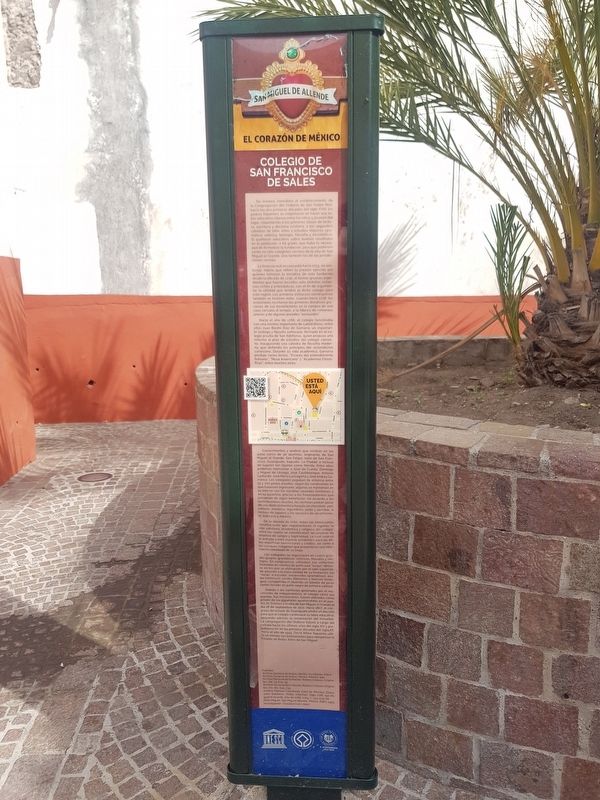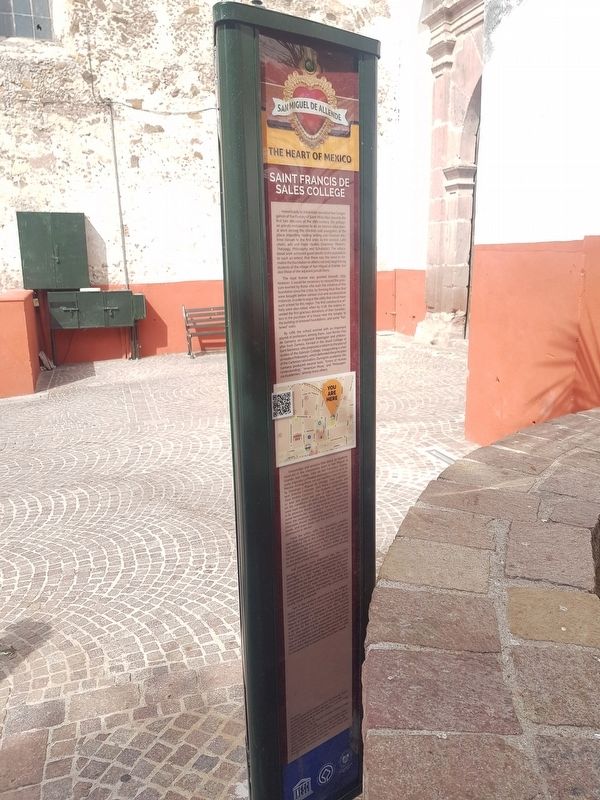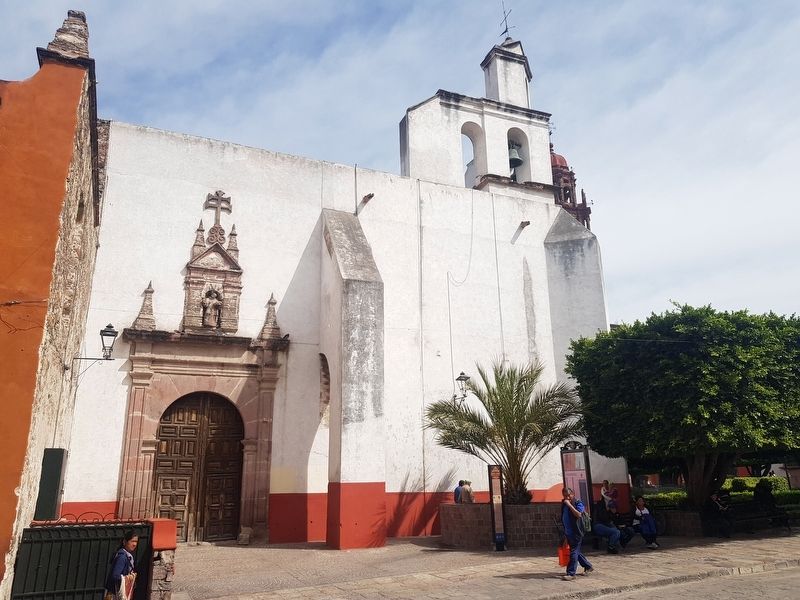San Miguel de Allende, Guanajuato, Mexico — The Central Highlands (North America)
Saint Francis de Sales College
San Miguel de Allende - El Corazón de México
De manera inmediata al establecimiento de la Congregación del Oratorio de San Felipe Neri, hacia las dos primeras décadas del siglo XVIII, los padres filipenses se empeñaron en hacer una labor educativa intensa entre los niños y jovenes del lugar, impartiendo a los primeros clases de lectura, escritura y doctrina cristiana, a los segundos, cátedra de latín, artes y estudios mayores (gramática, retórica, teología, filosofía y escolástica). El quehacer educativo cobró buenos resultados en la población a tal grado, que hubo la necesidad de formalizar la fundación, para que pudiesen asistir no sólo colegiales vecinos de la villa de San Miguel el Grande, sino también los de las jurisdicciones vecinas.
La licencia real se concedió hacia 1753, sin embargo, habría que referir la presión ejercida por quienes tomaron la iniciativa de esta fundación desde la década de 1730, al formar gruesos expedientes que fueron llevados ante distintas instancias civiles y eclesiásticas, con el fin de argumentar la utilidad que tendría el dicho colegio para esta región. Los primeros esfuerzos constructivos también se hicieron notar, cuando hacia 1738, los oratorianos invirtieron los primeros donativos graciosos de sus benefactores en la compra de una casa cercana al templo, a la fábrica de cimientos anexos y de algunas paredes “enrasadas”.
Hacia el año de 1766, el colegio funcionaba con una nómina importante de catedráticos, entre ellos Juan Benito Díaz de Gamarra, un importante teólogo y filósofo zamorano, formado en el colegio jesuita de San Ildefonso, quien propuso una reforma al plan de estudios del colegio salesiano, inaugurando una cátedra de filosofía moderna, que defendía los principios del racionalismo cartesiano. Durante su vida académica, Gamarra produjo varios textos: “Errores del entendimiento humano”, “Musa Americana” y “Academias Filosóficas”, entre muchos otros.
Conocimientos y análisis que recibían en las aulas cerca de 30 alumnos, originarios de San Miguel el Grande, San Felipe, Valle de San Francisco, Guanajuato, Irapuato, La Piedad, e incluso de lugares tan lejanos como Mérida. Entre ellos podemos mencionar a José de Cuesta, Domingo y Miguel de Unzaga, José Castilblanque, Antonio Lartundo, José María Lanzagorta y Jose Andrés Carranco. Los colegiales pagaban de estancia entre 12 y y 300 pesos anuales, según las condiciones que hubiesen ingresado; algunos se mantenían notables caudales familiares,
y en su ausencia, gracias a los finaciamentos que provenían de algún benefactor. De acuerdo a las contribuciones anuales, los alumnos podían gozar de una dieta alimenticia basada en chocolate, pan, carnero, manteca, legumbres, pollo y semillas, e incluso de zapatos y los servicios de un enfermero, boticario o médico.
De la década de 1760, datan las interesantes constituciones que reglamentaron el ingreso, la vida cotidiana, académica y religiosa del colegio; entre las cuales se consideraban las pruebas de limpieza de sangre y legitimidad. Lo cual reservó la entrada a este espacio académico para las elites españolas peninsulares y criollas, así como a los caciques indígenas que presentaron una información detallada de su linaje.
Los colegiales se organizaron en cuatro grandes grupos: gramáticos, retóricos, filósofos y teólogos. En congruencia, utilizaban sus uniformes formados en mantos de paño azul “turqui” obscuro, en los que se distinguían por el lado izquierdo, de acuerdo a la especialidad de su formación, las “vecas” o escudos; encarnados (gramáticos), azules (retóricos), verdes (filósofos) y blancos (teólogos), completaba el atuendo un bonete de picos cortos forrado en paño negro de primera calidad.
Debido a los conflictos generados por el movimiento de independencia, el colegio cerró sus puertas. Sus instalaciones, fueron utilizadas
como prisión de los españoles aprehendidos en el pueblo de Dolores y la villa de San Miguel el Grande el día 16 de septiembre de 1810. Hacia 1827, el congreso del estado de Guanajuato emitió un decreto para que el colegio continuase su labor educativa, apoyando además la restauración del inmueble. La congregación del Oratorio estuvo a cargo del colegio hasta los últimos años del siglo XIX y probablemente en las primeras décadas del siglo XX. Hacia el año de 1949, David Alfaro Siqueiros utilizó un tiempo sus instalaciones para reorganizar la Escuela de Bellas Artes de San Miguel.
Fuentes:
Archivo General de Indias, Sevilla, Escribanía, 209 A.
Archivo General de Indias, Sevilla; México, 445.
Archivo General de la Nación, Reales Cédulas Originales, Vol. 73, Exp. 32.
Archivo General de la Nación, Reales Cédulas Originales, Vol. 161, Exp. 239.
Archivo Manuel Castañeda, Casa de Morelos, Diocesano, Gobierno, Visitas, Informes, Siglo XVIII, San Miguel el Grande, Año de 1766, 0215, C. 504, Exp. 66.
Malo Miguel, San Miguel Allende, México, INAH, 1963.
Investigación: Graciela Cruz López
Saint Francis de Sales College
Immediately to the establishment of the Congregation of the Oratory of San Felipe Neri, towards the first two decades of the 18th century, the philippian priests endeavored to do an intense educational work among the children and young people of the place, imparting reading, writing and Christian doctrine classes to the first ones; to the second, Latin chairs, arts and major studies (Grammar, Rhetoric, Theology, Philosophy and Scholastic). The educational work achieved good results in the population, to such an extent, that there was the need to formalize the foundation to attend not only neighboring students of the village of San Miguel el Grande, but also those of the adjacent jurisdictions.
The royal license was granted towards 1753, however, it would be necessary to recount the pressure exerted by those who took the initiative of this foundation since the 1730s, by forming thick files that were brought before various civil and ecclesiastical instances, in order to argue the utility that would have such school for this region. The first constructive efforts were also noted, when by 1738, the orators invested the first gracious donations of their benefactors in the purchase of a house near the temple, to the building of annexed foundations, and some “flattened” walls.
By 1766, the school worked with an important payroll of professors, among them Juan Benito Díaz de Gamarra, an important theologian and philosopher from Zamora, formed in the Jesuit College of San Ildefonso, who proposed a reform to the plan of studies of the Salesian College, inaugurating a chair of modern Philosophy, which defended the principles of Cartesian rationalism. During his academic life, Gamarra produced several texts: "Errors of human understanding", "American Muse" and "Philosophical Academies", among many others.
Knowledge and analysis that about 30 students received in the classrooms, born in San Miguel el Grande, San Felipe, Valle de San Francisco, Guanajuato, Irapuato, La Piedad, and even in places as far as Mérida. Among them we can mention José de Cuesta, Domingo y Miguel de Unzaga, José Castilblanque, Antonio Lartundo, José María Lanzagorta and Jose Andrés Carranco. The students paid between 12 and 300 pesos per year of sojourn, depending on the conditions in which they had entered; some were kept inside with the notable family wealth, and in its absence, thanks to the funding that came from some benefactor. According to the annual contributions, the students could enjoy a food diet based on chocolate, bread, mutton, lard, legumes, chicken and seeds, and even shoes and the services of a nurse, pharmacist or doctor.
From the 1760s, date the interesting constitutions that regulated the income, the daily, academic and religious life of the school; among which were considered the blood cleansing and legitimacy tests. This reserved the entrance to this academic space for the peninsular and creole Spanish elites, as well as the indigenous caciques who presented detailed information of their lineage.
The students were organized into four major groups: grammarians, rhetoricians, philosophers and theologians. In congruence, they used their uniforms consisting in a dark “indigo” broadcloth, that were distinguished on the left side with “bacas” or shields according to the specialty of their formation; incarnate (grammarians), blue (rhetoricians), green (philosophers) and whites (theologians), the outfit was completed by a bonnet with short tips lined with top quality black broadcloth.
Due to the conflicts generated by the independence Movement, the school closed its doors. Its facilities were used as a prison for the Spaniards apprehended in the town of Dolores and the village of San Miguel el Grande on September 16, 1810. Towards 1827, the Congress of the state of Guanajuato issued a decree for the school to continue its educational work, also supporting the restoration of the building. The Congregation of the Oratory was in charge of the school until the last years of the 19th century and probably in the first decades of the 20th century. By 1949, David Alfaro Siqueiros used these facilities for a while to reorganize the School of Fine Arts of San Miguel.
Sources repeated in Spanish
Erected by El Honorable Ayuntamiento de San Miguel de Allende y UNESCO.
Topics. This historical marker is listed in these topic lists: Churches & Religion • Colonial Era • Education • Man-Made Features. A significant historical date for this entry is September 16, 1810.
Location. 20° 54.877′ N, 100° 44.542′ W. Marker is in San Miguel de Allende, Guanajuato. Marker is on San Francisco just west of Juárez, on the right when traveling west. Touch for map. Marker is in this post office area: San Miguel de Allende GTO 37700, Mexico. Touch for directions.
Other nearby markers. At least 8 other markers are within walking distance of this marker. Saint Francis Religious Ensemble (within shouting distance of this marker); The Remains of the Insurgents (within shouting distance of this marker); House of Ignacio Aldama (within shouting distance of this marker); Site of the Primitive Post Office (within shouting distance of this marker); Allende's Independence Meetings (about 90 meters away, measured in a direct line); José María de Jesús de Diez de Sollano y Dávalos (about 90 meters away); Here Independence was Planned (about 120 meters away); House of Francisco Lanzagorta (about 120 meters away). Touch for a list and map of all markers in San Miguel de Allende.
Credits. This page was last revised on September 1, 2020. It was originally submitted on March 26, 2019, by J. Makali Bruton of Accra, Ghana. This page has been viewed 182 times since then and 22 times this year. Photos: 1, 2, 3. submitted on March 26, 2019, by J. Makali Bruton of Accra, Ghana.


